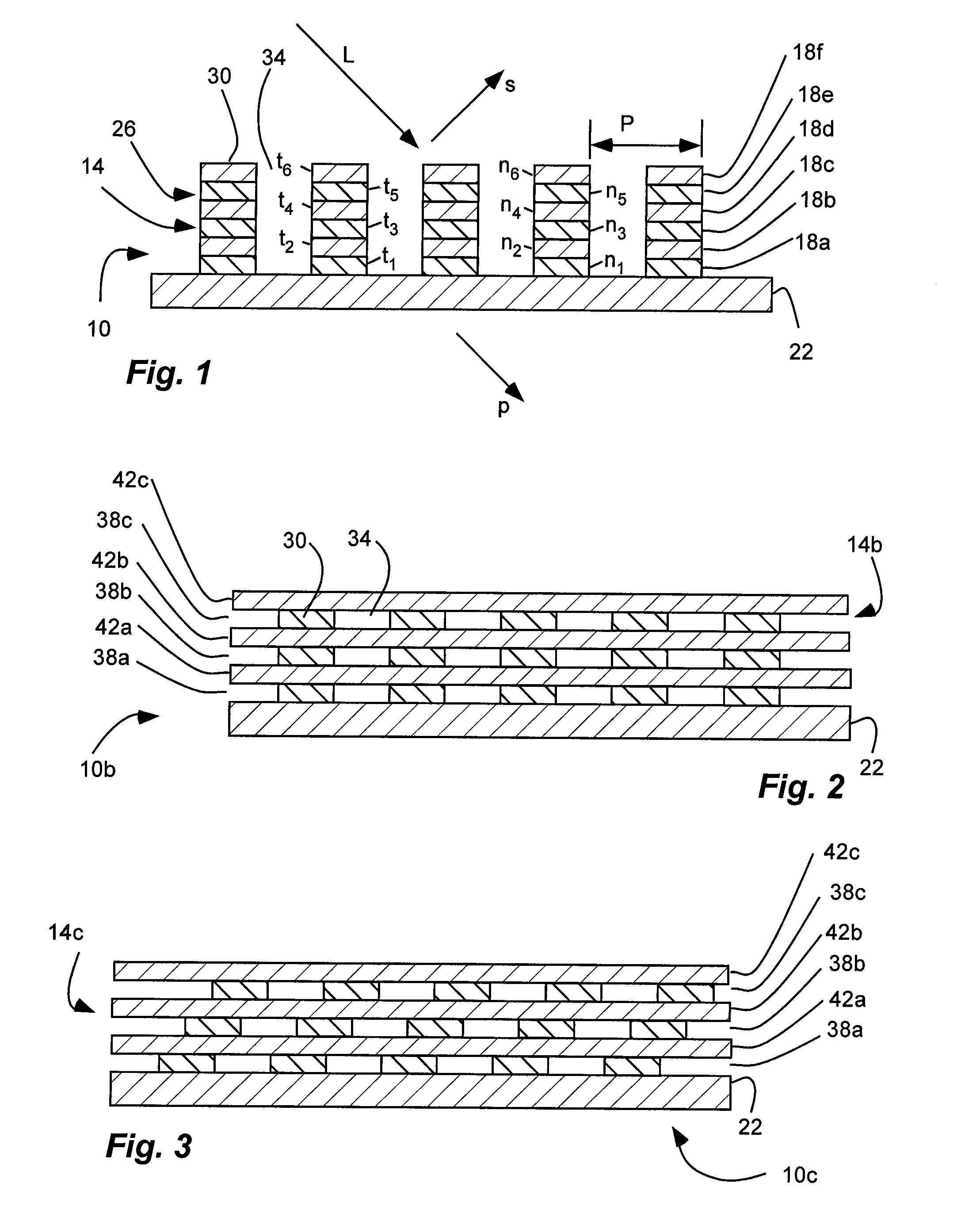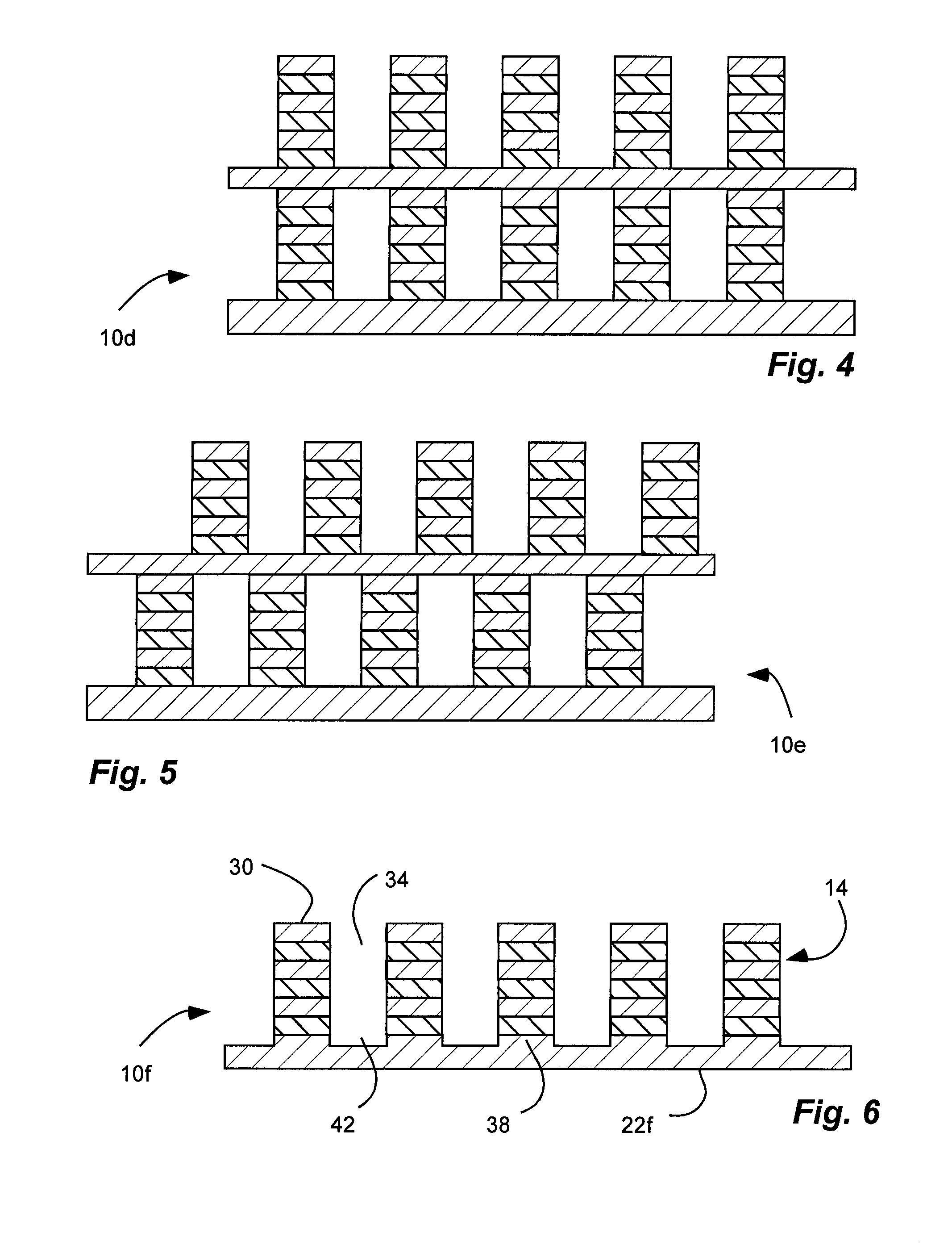Optical Polarization Beam Combiner/Splitter with an Inorganic, Dielectric Grid Polarizer
a technology of dielectric grid polarizer and optical polarization beam, which is applied in the direction of optics, polarising elements, instruments, etc., can solve the problems of conductive materials, high cost and weight, and organic polymer materials that are not as capable of withstand higher temperatures or higher energy flux, and achieve high energy flux, high contrast in reflection and/or transmission, and high energy flux
- Summary
- Abstract
- Description
- Claims
- Application Information
AI Technical Summary
Benefits of technology
Problems solved by technology
Method used
Image
Examples
example 1
[0059]Referring to FIG. 9a, a first non-limiting example of an inorganic, dielectric grid polarizer is shown.
[0060]The grid polarizer has a stack of fifteen film layers disposed over a substrate. The film layers are formed of inorganic and dielectric materials, namely alternating layers of silicon dioxide (SiO2)(n=1.45) and titanium dioxide (TiO2)(n=2.5). The bottom layer and the top layer are silicon dioxide. Thus, the layers alternate between higher and lower indices of refraction (n). The top and bottom layers have a thickness (t1 and t15) of 35 nm, while the intervening layers have a thickness (t2-14) of 71 nm. Thus, the entire stack has a thickness (ttotal) of approximately 1 μm or micron. All of the film layers are discontinuous and form an array 26 of parallel ribs 30. Thus, all of the layers are discontinuous to form form birefringent layers. The ribs have a pitch or period (p) of 180 nm, and a duty cycle (ratio of period to width) of 0.5 or width (w) of 90 nm.
[0061]Table 1 ...
example 2
[0062]Referring to FIG. 9b, a second non-limiting example of an inorganic, dielectric grid polarizer is shown.
[0063]The grid polarizer has a stack of fifteen film layers disposed over a substrate. The film layers are formed of inorganic and dielectric materials, namely alternating layers of silicon dioxide (SiO2)(n=1.45) and titanium dioxide (TiO2)(n=2.5). The bottom layer and the top layer are silicon dioxide. Thus, the layers alternate between higher and lower indices of refraction (n). The top and bottom layers have a thickness (t1 and t15) of 53 nm, while the intervening layers have a thickness (t2-14) of 106 nm. Thus, the entire stack has a thickness (ttotal) of approximately 1.5 μm or microns. All of the film layers are discontinuous and form an array 26 of parallel ribs 30. Thus, all of the layers are discontinuous to form form birefringent layers. The ribs have a pitch or period (p) of 260 nm, and a duty cycle (ratio of period to width) of 0.5 or width (w) of 130 nm.
[0064]Ta...
example 3
[0065]Referring to FIG. 9c, a third non-limiting example of an inorganic, dielectric grid polarizer is shown.
[0066]The grid polarizer has a stack of fifteen film layers disposed over a substrate. The film layers are formed of inorganic and dielectric materials, namely alternating layers of silicon dioxide (SiO2)(n=1.45) and titanium dioxide (TiO2)(n=2.5). The bottom layer and the top layer are silicon dioxide. Thus, the layers alternate between higher and lower indices of refraction (n). The top and bottom layers have a thickness (t1 and t15) of 44 nm, while the intervening layers have a thickness (t2-14) of 88 nm. Thus, the entire stack has a thickness (total) of approximately 1.2 μm or micron. All of the film layers are discontinuous and form an array 26 of parallel ribs 30. Thus, all of the layers are discontinuous to form form birefringent layers. The ribs have a pitch or period (p) of 230 nm, and a duty cycle (ratio of period to width) of 0.5 or width (w) of 115 nm.
[0067]Table ...
PUM
 Login to View More
Login to View More Abstract
Description
Claims
Application Information
 Login to View More
Login to View More - R&D
- Intellectual Property
- Life Sciences
- Materials
- Tech Scout
- Unparalleled Data Quality
- Higher Quality Content
- 60% Fewer Hallucinations
Browse by: Latest US Patents, China's latest patents, Technical Efficacy Thesaurus, Application Domain, Technology Topic, Popular Technical Reports.
© 2025 PatSnap. All rights reserved.Legal|Privacy policy|Modern Slavery Act Transparency Statement|Sitemap|About US| Contact US: help@patsnap.com



